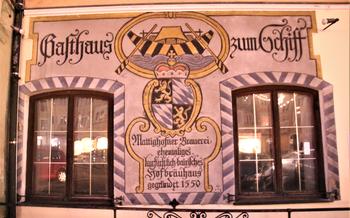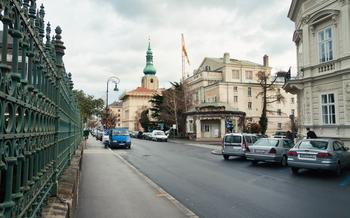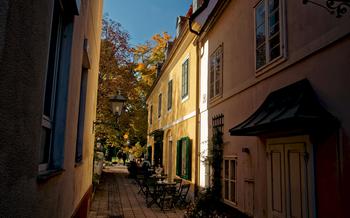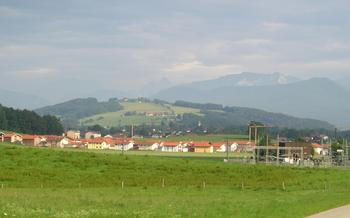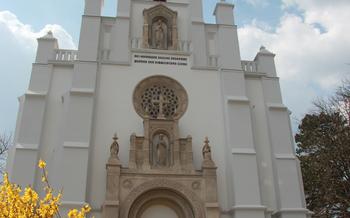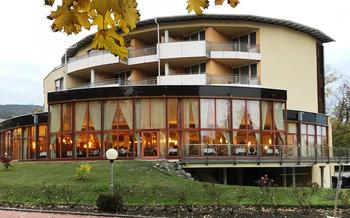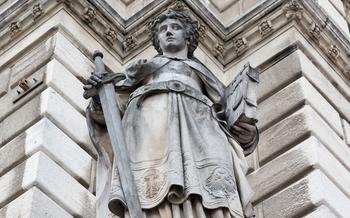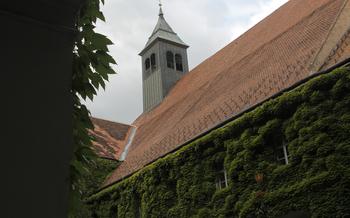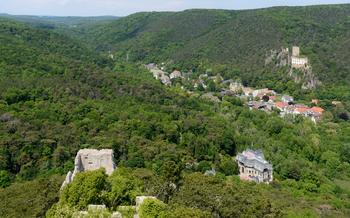
Vienna Woods (Wienerwald)
- History of the Vienna Woods (Wienerwald)
- Getting to the Vienna Woods (Wienerwald)
- Hiking in the Vienna Woods (Wienerwald)
- Biking in the Vienna Woods (Wienerwald)
- Swimming in the Vienna Woods (Wienerwald)
- Picnicking in the Vienna Woods (Wienerwald)
- Visiting the Sparbach Castle
- Exploring the Liechtenstein Castle
- Taking a ride on the cogwheel train
- Visiting the Cistercian Abbey of Heiligenkreuz
- Attending the annual Beethovenfest
- Visiting the Mayerling Hunting Lodge
- Taking a walk through the Helenental Valley
- Insider Tip: Exploring the Vienna Woods (Wienerwald) by Segway
History of the Vienna Woods (Wienerwald)
The Vienna Woods, or Wienerwald in German, is a sprawling forest that stretches from the outskirts of Vienna to the foothills of the Alps. It boasts a rich history that dates back to prehistoric times and has been a popular destination for recreation and relaxation for centuries.
Historical Background
Archeological evidence suggests that the Vienna Woods were home to human settlements as early as the Neolithic period. Later, the area was inhabited by Celtic tribes, who were eventually conquered by the Romans in the 1st century BC. The Romans built roads and villas in the region, and they also introduced viticulture, which is still practiced in the Vienna Woods today.
In the Middle Ages, the Vienna Woods was a hunting ground for the Habsburg emperors. They also built several castles in the area, including the Sparbach Castle and the Liechtenstein Castle. The forest was also used for forestry and agriculture and was home to a number of villages and monasteries.
Cultural Significance
The Vienna Woods have played an important role in Austrian culture and folklore. The forest has been a source of inspiration for artists, musicians, and writers, including Johann Strauss II, Franz Schubert, and Arthur Schnitzler. It has also appeared in numerous films and television shows.
Ecological Importance
The Vienna Woods is home to a diverse range of flora and fauna. The forest is dominated by beech trees, but there are also oak trees, maple trees, and pine trees. It is also home to a variety of animals, including deer, wild boar, foxes, and badgers. The Vienna Woods are also an important part of the city's water supply, as they filter the water that flows into the city's reservoirs.
Getting to the Vienna Woods (Wienerwald)
The Vienna Woods (Wienerwald) area is easily accessible from Vienna, with several transportation options available. The most convenient way to reach the woods is by train, with regular departures from Vienna's central train station (Wien Hauptbahnhof). The journey takes approximately 30 minutes, and trains stop at various stations within the Vienna Woods, allowing visitors to alight at the most convenient location for their chosen activity.
Alternatively, visitors can take the Badner Bahn, a local railway line that runs from Vienna to Baden, a town located on the edge of the Vienna Woods. The journey takes slightly longer than by train, but offers scenic views of the surrounding countryside.
For those who prefer to travel by car, the Vienna Woods are accessible via the A2 motorway, which connects Vienna to Graz. There are several exits along the motorway that lead into the woods, and parking is available at most trailheads and attractions.
The Vienna Woods are a popular destination year-round, but the best time to visit is during the spring or fall, when the weather is mild and the forests are at their most vibrant. Summer can be hot and humid, while winter can be cold and snowy, making it less ideal for outdoor activities.
The cost of visiting the Vienna Woods varies depending on the activities you choose to partake in. Hiking and biking are free, but there may be fees for parking, swimming, or visiting certain attractions. It's always advisable to check the websites of individual attractions or tour operators for specific pricing information.
Hiking in the Vienna Woods (Wienerwald)
The Vienna Woods (Wienerwald) offer a paradise for hikers of all levels. From easy paths that meander through picturesque valleys to challenging trails that lead to breathtaking viewpoints, there's something for everyone.
One of the most popular hiking trails is the Vierwallerweg, a 50-kilometer circular route that takes hikers through the heart of the Vienna Woods. The trail offers stunning views of the surrounding mountains and valleys, and passes through charming villages and historical landmarks.
Another popular trail is the Beethovenweg, a 12-kilometer trail that follows the footsteps of the composer Ludwig van Beethoven. The trail starts in Heiligenstadt, where Beethoven spent his summers, and leads to the Beethovenhaus in Vienna. Along the way, hikers can visit several places that were important to Beethoven's life and work.
For those who are looking for a more challenging hike, the Schneeberg Railway Trail is a great option. This 40-kilometer trail follows the route of the Schneeberg Railway, one of the steepest cogwheel railways in the world. The trail offers stunning views of the surrounding mountains and valleys, and is a great way to experience the beauty of the Vienna Woods from a different perspective.
No matter what your fitness level or interests, you're sure to find the perfect hiking trail in the Vienna Woods. With its stunning scenery, charming villages, and historical landmarks, the Vienna Woods are a hiker's paradise.
Biking in the Vienna Woods (Wienerwald)
Bike trails
The Vienna Woods (Wienerwald) offer a wide range of cycling paths that cater to different levels of experience. Whether you're a beginner or an experienced cyclist, you're sure to find a trail that suits your abilities. Some of the most popular bike trails include:
-
The Föhrenwald Trail is a relatively easy trail that is perfect for beginners. It runs for about 15 kilometers (9 miles) and is mostly flat, making it a great option for families with young children.
-
The Hirschenstein Trail is a more challenging trail that is suitable for intermediate cyclists. It runs for about 20 kilometers (12 miles) and features some steep climbs and descents.
-
The Höllental Trail is the most difficult bike trail in the Vienna Woods (Wienerwald). It runs for about 30 kilometers (18 miles) and features some very steep climbs and descents. This trail is only recommended for experienced cyclists.
Guided tours
If you're new to cycling in the Vienna Woods (Wienerwald), or if you'd simply like to explore the area with a guide, there are a number of guided tours available. These tours typically cover a variety of trails and can be customized to fit your needs.
Bike rentals
If you don't have your own bike, you can easily rent one from one of the many bike rental shops in the area. Bike rentals typically cost between €10 and €20 per day.
Swimming in the Vienna Woods (Wienerwald)
The Vienna Woods (Wienerwald) offer a variety of swimming lakes for those seeking refreshment on hot summer days. These lakes are fed by natural springs and boast crystal-clear water, making them ideal for swimming, sunbathing, and relaxing.
One of the most popular swimming lakes in the Vienna Woods is the Hinterbrühl Lake. Located just a short drive from Vienna, this lake features a sandy beach, a water slide, and a diving platform. There are also several restaurants and cafes nearby, making it a great place to spend the day.
Another popular option is the Sparbach Lake. This lake is surrounded by lush forests and offers a more secluded setting. There is a small beach area, as well as a number of hiking trails that start from the lake.
For those looking for a more adventurous experience, the Helenental Valley offers a number of swimming spots along the river. The water is cold and refreshing, and there are plenty of places to relax and enjoy the scenery.
No matter what your preference, you are sure to find a swimming spot in the Vienna Woods that suits you. So pack your swimsuit and towel, and head on out for a refreshing dip!
Water Quality
The water quality in the Vienna Woods swimming lakes is generally very good. The lakes are regularly tested by the authorities, and they meet all the required standards for swimming.
Beach Facilities
Most of the swimming lakes in the Vienna Woods have basic beach facilities, such as changing rooms, showers, and toilets. Some lakes also have restaurants, cafes, and sun loungers for rent.
Picnicking in the Vienna Woods (Wienerwald)
The Vienna Woods are a great place to enjoy a picnic, with many designated areas and plenty of natural beauty to admire. Here are some tips and suggestions for planning a picnic in the Vienna Woods.
There are several designated picnic areas, with tables and benches, located throughout the Vienna Woods. Some popular picnic spots include the Lainzer Tiergarten, the Prater, and the Donauinsel.
When packing your picnic basket, be sure to include plenty of food and drinks, as well as snacks and activities for the kids. Some popular picnic foods include sandwiches, chips, fruit, and cookies.
In addition to eating and drinking, there are plenty of other activities you can enjoy during your picnic in the Vienna Woods. Hiking, biking, and swimming are all popular ways to spend a day in the woods. You can also visit one of the many castles or abbeys in the area, or take a ride on the cogwheel train.
Picnicking in the Vienna Woods is a great way to enjoy the outdoors and spend time with family and friends. So pack a basket, find a spot, and get ready to relax and enjoy the natural beauty of the Vienna Woods.
Visiting the Sparbach Castle
The Sparbach Castle, nestled amidst the picturesque landscapes of the Vienna Woods, is a captivating historical gem that invites visitors to delve into its rich past. Erected during the 12th century, this majestic fortress has withstood the test of time, serving as a testament to the region's tumultuous history.
As you approach the castle, its imposing presence commands attention. Its sturdy stone walls, adorned with intricate carvings and weathered battlements, hint at the stories it holds within. Embark on a guided tour, and let the knowledgeable guides transport you back in time, narrating tales of knights, battles, and the noble families who once resided here.
At Sparbach Castle, history comes alive as you explore its well-preserved chambers. Marvel at the grand banqueting hall, where lavish feasts and royal gatherings once took place. Gaze upon the intricate frescoes and tapestries that adorn the walls, each telling a chapter in the castle's storied past.
Beyond its historical significance, Sparbach Castle also serves as a vibrant cultural venue. Throughout the year, it hosts a variety of events that celebrate the region's rich heritage. From medieval festivals and reenactments to concerts and art exhibitions, there's always something to captivate and entertain visitors.
Whether you're a history buff, an art enthusiast, or simply seeking a day of exploration, Sparbach Castle offers a unique and memorable experience. Its enchanting atmosphere, coupled with its historical and cultural significance, makes it a must-visit destination in the Vienna Woods.
Exploring the Liechtenstein Castle
Immerse yourself in the grandeur of the Liechtenstein Castle, an architectural masterpiece nestled amidst the picturesque landscapes of the Vienna Woods. Embark on a journey through time as you explore its rich history dating back to the 12th century.
In the 14th century, the castle was acquired by the powerful Liechtenstein family, who transformed it into their ancestral home. Over the centuries, the castle underwent several renovations and expansions, culminating in the magnificent structure that stands today.
Delve into the captivating history of the Liechtenstein family, one of the most influential dynasties in European history. Discover their legacy through the castle's grand halls, opulent chambers, and priceless collection of art and artifacts.
Stroll through the castle's meticulously manicured gardens, designed in the enchanting English landscape style. Admire the vibrant blooms, tranquil ponds, and sculptures that harmoniously blend with the surrounding natural beauty.
Visit the Liechtenstein Museum, housed within the castle, and immerse yourself in the family's fascinating history and cultural contributions. Explore interactive exhibits, captivating displays, and multimedia presentations that bring the past to life.
Whether you're a history buff, an art enthusiast, or simply seeking a glimpse into the grandeur of a bygone era, the Liechtenstein Castle offers an unforgettable experience that will leave you spellbound.
Taking a ride on the cogwheel train
History
The cogwheel train, known as the Dampf-Zahnradbahn in German, is a historic railway that has been operating in the Vienna Woods since 187It was built to transport passengers and goods between the towns of Baden and Heiligenkreuz, and was one of the first cogwheel trains in the world. The line is 2 kilometers long and has a gradient of up to 25%, making it one of the steepest cogwheel railways in Europe.
Route
The cogwheel train starts its journey at the Baden train station and climbs steadily through the Vienna Woods, passing through the towns of Weissenbach and Rauhenstein. The line offers stunning views of the surrounding countryside, including the vineyards, forests, and mountains of the Vienna Woods. The train also passes by several historical landmarks, including the Sparbach Castle and the Cistercian Abbey of Heiligenkreuz.
Scenic views
The cogwheel train is a popular tourist attraction, and many people visit the Vienna Woods just to take a ride on the train. The views from the train windows are breathtaking, and passengers can enjoy panoramic views of the Vienna Woods and the surrounding countryside. The train also passes through several tunnels, which offer a unique and unforgettable experience.
Visiting the Cistercian Abbey of Heiligenkreuz
History
The Cistercian Abbey of Heiligenkreuz, located in the town of Heiligenkreuz, just outside of Vienna, is one of Austria's oldest and most well-preserved medieval monasteries. It was founded in 1133 by a group of monks from the French abbey of Morimond and quickly became one of the most important religious and cultural centers in the region. Over the centuries the abbey has undergone numerous renovations and expansions, but much of its original Romanesque architecture can still be seen today.
Architecture
The abbey is a treasure trove of medieval art and architecture. The highlight is the Gothic cloister, built in the 13th century and featuring intricate carvings and stained glass windows depicting scenes from the Bible. The abbey church, consecrated in 1187, is a masterpiece of Romanesque architecture with its massive stone vaults and ornate frescoes. The chapter house, the refectory, and the library are all beautifully preserved and offer a glimpse into monastic life in the Middle Ages.
Cultural Significance
The abbey has played a significant role in Austrian history and culture. It was a center of learning and scholarship during the Middle Ages and was home to a renowned scriptorium where manuscripts were produced. The abbey also played an important role in the development of the Cistercian order in Austria and was instrumental in the foundation of several other Cistercian monasteries throughout the country.
Today, the abbey is still a functioning monastery, home to a community of about 80 Cistercian monks. It is also a popular tourist destination, attracting visitors from around the world who come to admire its stunning architecture, its rich history, and the peaceful atmosphere that pervades the grounds.
Attending the annual Beethovenfest
The Beethovenfest is an annual music festival held in Vienna, Austria, that celebrates the life and work of the renowned composer Ludwig van Beethoven. It is one of the most prestigious classical music festivals in the world and attracts music lovers from around the globe.
The festival was first held in 1978 and has been held annually since then. It typically takes place in September and features a range of concerts, recitals, and other events, all centered around the music of Beethoven.
The festival program is varied and includes performances by renowned orchestras, conductors, and soloists from around the world. There are also lectures, exhibitions, and film screenings related to Beethoven's life and work.
Tickets for the Beethovenfest go on sale in April and can be purchased online or through the festival box office. Prices vary depending on the type of event and seating category.
The Beethovenfest is a unique opportunity to experience the music of one of the greatest composers of all time in the city where he lived and worked. It is a must-attend event for any classical music enthusiast.
Visiting the Mayerling Hunting Lodge
Nestled amidst the picturesque landscapes of the Vienna Woods, the Mayerling Hunting Lodge holds a tragic and intriguing history. Built in the 16th century, this former hunting retreat gained notoriety in 1889 when Crown Prince Rudolf, the heir to the Austro-Hungarian throne, and his lover, Baroness Mary Vetsera, were found dead under mysterious circumstances. What transpired on that fateful night remains a subject of speculation and conspiracy theories to this day.
Today, the Mayerling Hunting Lodge is open to the public as a museum, offering a glimpse into the lives and tragic love story of Crown Prince Rudolf and Baroness Vetsera. Visitors can explore the lodge's well-preserved interiors, including the prince's study, the baroness's bedroom, and the dining room where the tragic events unfolded. The museum also houses a collection of artifacts related to the Mayerling incident, including personal belongings, photographs, and letters.
Guided tours are available to provide visitors with a deeper understanding of the historical context and significance of the Mayerling tragedy. These tours delve into the lives of Crown Prince Rudolf and Baroness Vetsera, their ill-fated romance, and the events leading up to their deaths. Through captivating storytelling, guides bring to life the drama and intrigue that shroud the Mayerling incident.
Taking a walk through the Helenental Valley
Nestled in the heart of the Vienna Woods, the Helenental Valley is a breathtaking gorge that offers a picturesque escape from the urban hustle and bustle. Its name, meaning Helen's Valley, originates from the legendary figure of Helen of Troy, who is said to have bathed in the valley's pristine waters. Steeped in history and natural beauty, the Helenental Valley is a must-visit destination for hikers and nature enthusiasts alike.
The valley's captivating landscape is characterized by towering cliffs, cascading waterfalls, and lush forests. A network of well-maintained hiking trails winds through the valley, offering visitors the chance to explore its hidden gems. One of the most popular trails leads to the Helenental Waterfall, a stunning cascade that plunges into a deep pool below. Along the way, hikers can admire the valley's diverse flora and fauna, including rare orchids and colorful butterflies.
For those seeking a more leisurely experience, the Helenental Valley is also home to several charming cafés and restaurants. Visitors can enjoy a refreshing drink or a delicious meal while soaking in the valley's tranquil atmosphere. Whether you're an avid hiker or simply looking for a relaxing day in nature, the Helenental Valley has something to offer everyone.
Insider Tip: Exploring the Vienna Woods (Wienerwald) by Segway
Why Segway?
Segways are a fun and unique way to explore the Vienna Woods. They are easy to learn to ride and allow you to cover more ground than you would on foot. This makes them a great option for people who want to see as much of the forest as possible in a short amount of time.
Tours
There are a number of companies that offer Segway tours of the Vienna Woods. These tours typically last for around two hours and cover a variety of terrain, including forest trails, meadows, and vineyards. Most tours include a guide who will point out interesting sights and share stories about the history and culture of the region.
Rental Options
If you prefer to explore the Vienna Woods on your own, you can rent a Segway from one of the many rental shops in the area. Rentals typically cost around €20 per hour. Once you have rented a Segway, you can choose your own route and explore the forest at your own pace.
